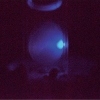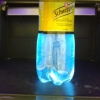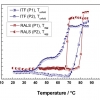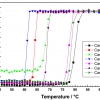Articles
Intrinsic fluorescence of proteins as a medical diagnostic tool
Dmitry Gakamsky and Anna Gakamsky describe how fluorescence may be used to diagnose cataracts in human eye lenses. Further, it may also be able to grade cataracts and monitor the disease’s progress, which may help discover metabolic and ambient factors that influence the progress of the disease.
The CAL(AI)2DOSCOPE: a microspectrophotometer for accurate recording of correlated absorbance and fluorescence emission spectra
The CAL(AI)2DOSCOPE (Cryogenic Absorption/Luminescence Alignment Independent Alternative Intermittent Detection Optical µSCOPE) is a microspectrometer that was constructed with the aim to facilitate the correlated investigation of absorption and fluorescence emission properties of nanovolumic protein samples under modulatable actinic illumination.
Glowing colours of foods: application of fluorescence and chemometrics in food studies
Whilst the major components of food are usually non-fluorescent, many minor food components that affect its nutritive, compositional and technological quality are fluorescent. Given its sensitivity, ease of use and non-destructive nature, this makes it useful in many applications around monitoring food processing and in fundamental food research.
Optical spectroscopy in therapy response monitoring: an awakening giant
“Optical spectroscopy in therapy response monitoring: an awakening giant” by Arja Kullaa, Surya Singh, Jopi Mikkonen and Arto Koistinen looks at the important advances made by optical spectroscopy techniques, such as diffuse optical spectroscopic imaging (DOSI), Raman, diffuse reflectance and fluorescence spectroscopy, in changing how cancer is managed in patients. The ability to repeatedly monitor tumour dynamics to see how effective a particular treatment has been has enormous potential for us all.
Orthogonal spectroscopic techniques for the early developability assessment of therapeutic protein candidates
Orthogonal spectroscopic techniques for the early developability assessment of therapeutic protein candidates” are described by Patrick Garidel, Anne Karow and Michaela Blech. Due to its cost and time implications, in the early development phase of drug discovery the use of othogonal techniques, based on different physical observables, is important for correct decision-making.
Right angle light scattering protein thermostability screening: from research to development
In the pharmaceutical industry, biologicals are of increasing interest due to their high therapeutic benefits. Amongst many other questions, the stability of new canditates is of great importance. Patrick Garidel describes this in “Right angle light scattering protein thermostability screening: from research to development”. The ability of this and other fluorescence-based techniques to detect very small quantities is of great benefit.
Complementary spectroscopic analyses of varnishes of historical musical instruments
For the past two centuries, the nature of the varnishes coating historical instruments has been a much debated subject. Focusing in particular on the varnishes used for coating violins made by the Italian instrument-maker Antonio Stradivari, numerous hypotheses have been raised by instrument-makers, experts, musicians and chemists, without reaching a general understanding of the ancient varnishing techniques. A few years ago, we decided to work on this topic using several complementary approaches for materials characterisation and study of historical sources (ancient varnish recipes, etc.).
Steady-state intrinsic tryptophan protein fluorescence spectroscopy in pharmaceutical biotechnology
Over the last two decades therapeutic antibodies have become the fastest growing area in pharmaceutical biotechnology. The medical significance of these therapeutic entities is highlighted by the commercial availability of about 20 products on the market with more than 160 candidates evaluated in different clinical trials. One reason for the success of antibodies as therapeutic agents is related to the large advancement in their biotechnological production via fermentation. Nowadays titers of about 4 g L–1 in 11-day fed-batch mode using the CHO BI HEX process are achievable using CHO-cells (CHO: chinese hamster ovary).
Understanding and measuring photooxidation in dairy products by fluorescence spectroscopy
Jens Petter Wold
MATFORSK, Norwegian Food Research Institute, Osloveien 1, 1430 Ås, Norway
Trilinear fluorescence spectroscopy
Trilinear fluorescence spectroscopy is emerging as one of the most powerful techniques to study chemical equilibria, monitor chemical reactions and to analyse test samples. But what is trilinear fluorescence spectroscopy?







